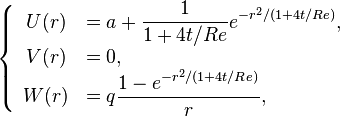Batchelor vortex
In fluid dynamics, Batchelor vortices, first described by George Batchelor in a 1964 article, have been found useful in analyses of airplane vortex wake hazard problems.
The model
The Batchelor vortex is an approximate solution to the Navier-Stokes equations obtained using a boundary layer approximation. The physical reasoning behind this approximation is the assumption that the axial gradient of the flow field of interest is of much smaller magnitude than the radial gradient.
The axial, radial and azimuthal velocity components of the vortex are denoted  ,
, and
and  respectively and can be represented in cylindrical coordinates
respectively and can be represented in cylindrical coordinates  as follows:
as follows:
The parameters in the above equations are
-
 , the free-stream axial velocity,
, the free-stream axial velocity, -
 , the velocity scale (used for nondimensionalization),
, the velocity scale (used for nondimensionalization), -
 , the length scale (used for nondimensionalization),
, the length scale (used for nondimensionalization), -
 , a measure of the core size, with initial core size
, a measure of the core size, with initial core size  and
and  representing viscosity,
representing viscosity, -
 , the swirl strength, given as a ratio between the maximum tangential velocity and the core velocity.
, the swirl strength, given as a ratio between the maximum tangential velocity and the core velocity.
Note that the radial component of the velocity is zero and that the axial and azimuthal components depend only on  .
.
We now write the system above in dimensionless form by scaling time by a factor  . Using the same symbols for the dimensionless variables, the Batchelor vortex can be expressed in terms of the dimensionless variables as
. Using the same symbols for the dimensionless variables, the Batchelor vortex can be expressed in terms of the dimensionless variables as
where  denotes the free stream axial velocity and
denotes the free stream axial velocity and  is the Reynolds number.
is the Reynolds number.
If one lets  and considers an infinitely large swirl number then the Batchelor vortex simplifies to the Lamb–Oseen vortex for the azimuthal velocity:
and considers an infinitely large swirl number then the Batchelor vortex simplifies to the Lamb–Oseen vortex for the azimuthal velocity:
where  is the circulation.
is the circulation.


